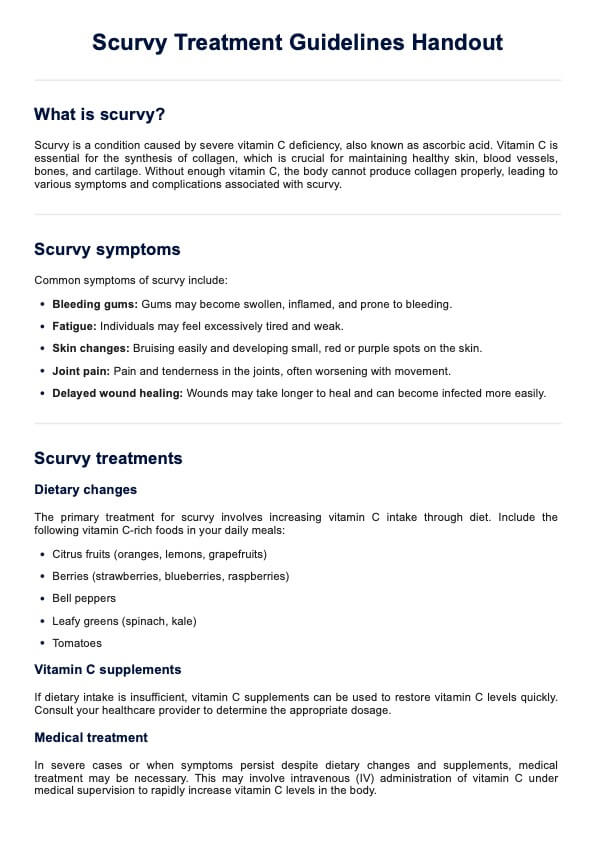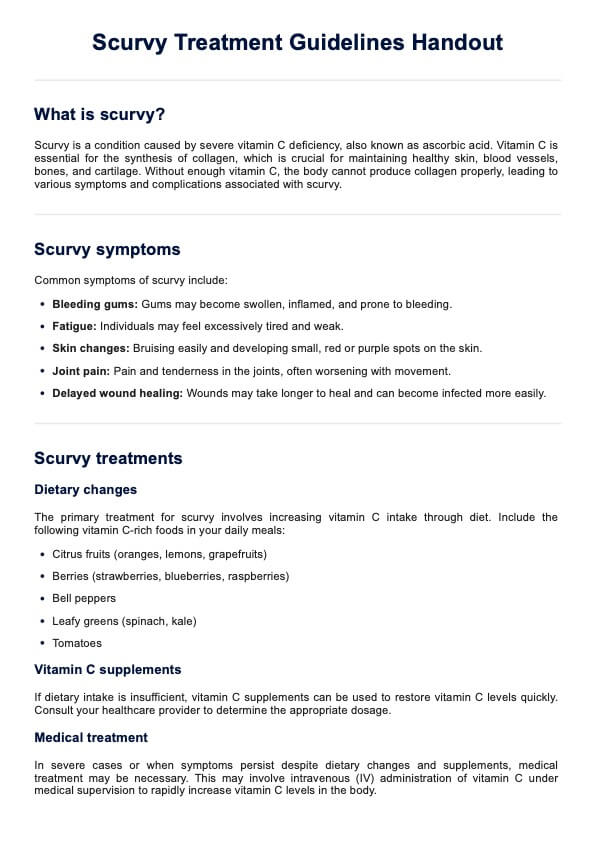Scurvy Treatment Guidelines Handout
Learn about the treatment guidelines and examples for scurvy, a condition caused by vitamin C deficiency. Download Carepatron's free PDF guide for valuable information.


What is scurvy?
Scurvy is a disease resulting from severe vitamin C deficiency, also known as ascorbic acid. It occurs when the body doesn't have enough vitamin C, an essential nutrient for the synthesis of collagen, wound healing, and the maintenance of cartilage, bones, and teeth. Scurvy symptoms can manifest as fatigue, muscle weakness, joint and muscle aches, and bleeding gums. These symptoms of scurvy arise due to the weakening of connective tissues, blood vessels, and bones, which depend on vitamin C for proper function.
The condition is often associated with a poor diet that lacks fresh fruits and vegetables, particularly citrus fruits and other vitamin C-rich foods. Individuals who do not consume enough of these foods are at higher risk of developing nutritional deficiencies, including scurvy. Historically, scurvy was common among sailors and soldiers with limited access to fresh produce during long voyages or military campaigns.
To prevent scurvy, it is crucial to maintain adequate vitamin C levels through a balanced diet or supplements. Consuming a variety of fruits and vegetables can help prevent vitamin deficiencies and ensure overall health. If dietary intake is insufficient, dietary supplements can provide the necessary nutrients to prevent scurvy and other deficiencies.
Scurvy Treatment Guidelines Handout Template
Scurvy Treatment Guidelines Handout Example
Scurvy treatments
Scurvy, resulting from a vitamin C deficiency, is a preventable and treatable condition. Effective treatments focus on replenishing the body's ascorbic acid levels and addressing any underlying risk factors. Here, we discuss the various treatments for scurvy in detail.
Dietary changes
One of the primary treatments for scurvy is making dietary changes to include more fresh fruits and vegetables. These foods are rich sources of vitamin C and can help increase vitamin C levels in the human body. Citrus fruits, strawberries, kiwi, bell peppers, and leafy greens are particularly effective in combating vitamin C deficiency. By consuming these fresh fruit and vegetable options regularly, the symptoms of scurvy can be alleviated, and overall health can be maintained.
Vitamin C supplements
In cases where dietary intake is insufficient, vitamin C supplements can be used to treat scurvy. These supplements provide a concentrated dose of ascorbic acid, helping to quickly raise the body's vitamin C levels. Vitamin C supplements are especially beneficial for individuals who have difficulty absorbing vitamin C from their diet or have severe deficiencies. Regular supplementation can help restore the normal function of red blood cells, enhance the immune system, and improve overall health.
Medical treatment
For severe cases of scurvy, medical treatment may be necessary. This involves administering higher doses of vitamin C under medical supervision to ensure that the body can properly absorb vitamin C and effectively combat the deficiency. Medical professionals will monitor serum vitamin C levels and adjust treatment as needed to ensure the scurvy is treated effectively.
How to use our treatment guidelines handout
This handout is designed to provide comprehensive information and support, ensuring that patients understand the importance of addressing their severe deficiency. Below are the steps on how to use our handout template to its full potential.
Access and download the handout
To begin, medical professionals should access and download the treatment guidelines handout from this page.
Introduce the handout to the patient
When introducing the handout to the patient, medical professionals should explain the purpose and importance of the document. Highlight the symptoms of severe scurvy, such as red or blue spots on the skin, poor wound healing, and body aches, to emphasize the need for treatment.
Educate the patient
Explain the impact of insufficient intake of vitamin C and how it can lead to severe deficiency and other nutritional deficiencies. Address any specific concerns, such as poor wound healing or dietary restrictions due to an eating disorder, to ensure personalized care.
How can healthcare professionals benefit from our template?
Carepatron's handout template for scurvy treatment offers medical professionals several advantages in managing and educating patients about this condition effectively. Below are three key benefits:
Clear patient education
Our handout provides clear, concise information on symptoms, diagnosis, and treatment options for scurvy. It helps healthcare professionals educate patients about the importance of consuming more vitamin C through a nutritious diet or supplements.
Structured treatment guidelines
The template offers structured treatment guidelines, outlining step-by-step recommendations for managing scurvy. It includes information on how much vitamin C is needed daily, dietary sources rich in vitamin C, and the role of vitamin C in iron absorption and collagen synthesis.
Enhanced patient engagement
Using our handout enhances patient engagement during consultations. It visually reinforces key points discussed, such as the consequences of untreated scurvy, including bone pain and weakened connective tissue. Medical professionals can use the handout to discuss diagnostic tests, medical treatments, and the importance of addressing scurvy promptly.
Commonly asked questions
The time to cure scurvy depends on the severity of the deficiency and adherence to treatment. Improvement can be seen within weeks of adequate vitamin C intake.
Untreated scurvy can lead to serious complications such as gum disease, joint pain, and impaired wound healing. Severe cases may result in anemia and damage to the bones and connective tissues.
Common symptoms of scurvy include bleeding gums, fatigue, and bruising easily. Other signs may include joint pain, irritability, and swollen or painful limbs.
The fastest way to cure scurvy is to increase vitamin C intake through diet or supplements. Consuming vitamin C-rich foods like citrus fruits, strawberries, and bell peppers can quickly reverse symptoms when taken consistently.







































































































